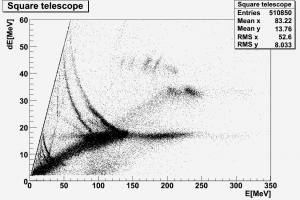
In experimental physics, ΔE-E detectors, known as telescopes, are powerful devices for charged particles identification. Telescopes consisting of pairs of thin and thick surface-barrier detectors can be used to provide charged-particle identification. These detectors must be positioned in series. The velocity is deduced from the stopping power measured in the thin detectors (ΔE detectors). There is a strong correlation between the energy deposited in each detector. This correlation depends on the mass (A), the charge (Z), and the kinetic energy (E) of each particle. The mass is deduced from the range or the total kinetic energy loss in the thicker detector (E detector).
Telescopes can be composed of several detectors (ionization chambers, silicon detectors, and scintillators, for instance) stacked to slow down incident-charged particles, the first detector being the thinnest and the last one the thickest. CsI scintillation counters can be, for example, used as final E counters. As an example of a telescope, an assembly based on two front ΔE silicon detectors (10 or 30 µm) and an E silicon counter 1500 µm thick may be used to detect high-energy charged particles.